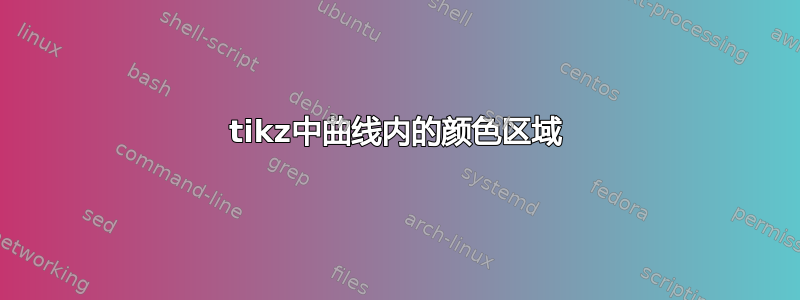
\documentclass{standalone}
\usepackage{tikz}
\begin{document}
\begin{tikzpicture}
\node (mth) [align=center] at (0,0) {parameter space of\\[2ex]{\Large M-Theory}};
\node (so32) [align=center] at (-5,-1) {heterotic\\$SO(32)$};
\node (e8e8) [align=center] at (-3,4) {heterotic\\$E(8) \times E(8)$};
\node (tiia) [align=center] at (4,3) {Type II A};
\node (tiib) [align=center] at (5,-2) {Type II B};
\node (ti) [align=center] at (0,-5) {Type I};
\draw[bend left,<->] (so32) to node [below right,align=center] {compac-\\tification} (e8e8);
\draw[bend left,<->] (e8e8) to node [below left] {M-theory} (tiia);
\draw[bend left,<->] (tiia) to node [below left] {T-duality} (tiib);
\draw[bend left,<->] (tiib) to node [above left,align=center] {orientifold\\action $\Omega$} (ti);
\draw[bend left,<->] (ti) to node [above right] {S-duality} (so32);
\draw[bend right,very thick] (so32.east) to (e8e8.south);
\draw[bend right,very thick] (e8e8.south) to (tiia.south);
\draw[bend right,very thick] (tiia.south) to (tiib.west);
\draw[bend right,very thick] (tiib.west) to (ti.north);
\draw[bend right,very thick] (ti.north) to (so32.east);
\end{tikzpicture}
\end{document}
我想将粗黑线封闭的区域(即)涂成parameter space浅灰色。有人知道简单的方法吗?此外,我如何才能像这张图片一样在五个角上添加弯曲的灰线?
答案1
对于背景的颜色,您可以将其全部绘制为一条路径,然后填充。对于弯曲的灰线,您可以使用剪辑和圆圈,如下所示:
\documentclass[tikz]{standalone}
\begin{document}
\begin{tikzpicture}
\pgfdeclarelayer{background}
\pgfsetlayers{background,main}
\node (mth) [align=center] at (0,0) {parameter space of\\[2ex]{\Large M-Theory}};
\node (so32) [align=center] at (-5,-1) {heterotic\\$SO(32)$};
\node (e8e8) [align=center] at (-3,4) {heterotic\\$E(8) \times E(8)$};
\node (tiia) [align=center] at (4,3) {Type II A};
\node (tiib) [align=center] at (5,-2) {Type II B};
\node (ti) [align=center] at (0,-5) {Type I};
\draw[bend left,<->] (so32) to node [below right,align=center] {compac-\\tification} (e8e8);
\draw[bend left,<->] (e8e8) to node [below left] {M-theory} (tiia);
\draw[bend left,<->] (tiia) to node [below left] {T-duality} (tiib);
\draw[bend left,<->] (tiib) to node [above left,align=center] {orientifold\\action $\Omega$} (ti);
\draw[bend left,<->] (ti) to node [above right] {S-duality} (so32);
\begin{pgfonlayer}{background}
\draw[bend right,very thick, fill=lightgray]
(so32.east)
to (e8e8.south)
to (tiia.south)
to (tiib.west)
to (ti.north)
to (so32.east);
\begin{scope}
\clip[bend right]
(so32.east)
to (e8e8.south)
to (tiia.south)
to (tiib.west)
to (ti.north)
to (so32.east);
\foreach \c in {so32.east,e8e8.south,tiia.south,tiib.west,ti.north,so32.east}{%
\foreach \r in {1,...,4}{%
\draw[darkgray] (\c) circle (\r*0.25cm);
}
}
\end{scope}
\end{pgfonlayer}
\end{tikzpicture}
\end{document}
其结果是
当然,您可以根据自己的喜好自定义填充和曲线的颜色。
答案2
对于第一部分,只需将内部路径构建为单个\draw命令而不破坏路径:
\documentclass{standalone}
\usepackage{tikz}
\begin{document}
\begin{tikzpicture}
\node (so32) [align=center] at (-5,-1) {heterotic\\$SO(32)$};
\node (e8e8) [align=center] at (-3,4) {heterotic\\$E(8) \times E(8)$};
\node (tiia) [align=center] at (4,3) {Type II A};
\node (tiib) [align=center] at (5,-2) {Type II B};
\node (ti) [align=center] at (0,-5) {Type I};
\draw[bend left,<->] (so32) to node [below right,align=center] {compac-\\tification} (e8e8);
\draw[bend left,<->] (e8e8) to node [below left] {M-theory} (tiia);
\draw[bend left,<->] (tiia) to node [below left] {T-duality} (tiib);
\draw[bend left,<->] (tiib) to node [above left,align=center] {orientifold\\action $\Omega$} (ti);
\draw[bend left,<->] (ti) to node [above right] {S-duality} (so32);
\draw[bend right,very thick,fill=black!20]
(so32.east) to (e8e8.south)
to (tiia.south)
to (tiib.west)
to (ti.north)
to (so32.east)
;
\node (mth) [align=center] at (0,0) {parameter space of\\[2ex]{\Large M-Theory}};
\end{tikzpicture}
\end{document}
我必须将mth节点移到填充区域下方,以便它显示在填充区域上方。如果您需要在此之前创建它,但仍将其放在前台,您可以使用
\pgfdeclarelayer{background}
\pgfsetlayers{background,main}
然后在背景中绘制填充的路径:
\begin{pgfonlayer}{background}
\draw[bend right,very thick,fill=black!20]
(so32.east) to (e8e8.south)
to (tiia.south)
to (tiib.west)
to (ti.north)
to (so32.east)
;
\end{pgfonlayer}
对于第二个问题,您可能会发现该angles库很有用,它记录在 PGF 最新版本手册的第 39 节中。





